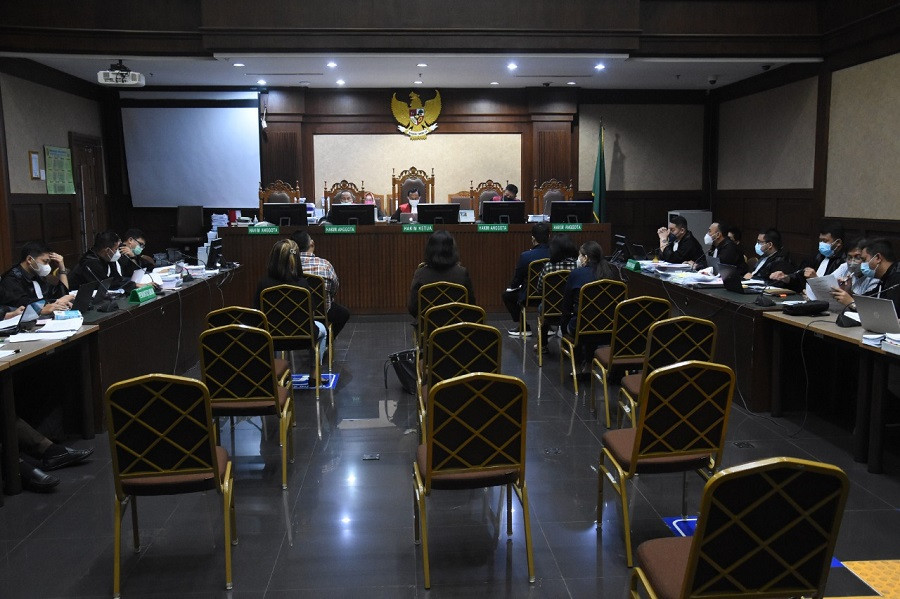Popular Reads
Top Results
Can't find what you're looking for?
View all search resultsPopular Reads
Top Results
Can't find what you're looking for?
View all search resultsMaking national life insurance industry more transparent
Insurance products in the category of investment-linked insurance products (PAYDI), such as unit links, are suspected of being the root cause of an insurance company's problems in many cases.
Change text size
Gift Premium Articles
to Anyone

A
study published in 2000 by Rudolph Enz titled The S-Curve Relationship Between Per-Capita Income and Insurance Penetration concluded that in the relationship between life insurance penetration and gross domestic product (GDP), there is an S curve with a lower inflection point at a per-capita GDP of US$4,871 and an upper inflection point at a per-capita GDP of $13,863.
According to the trajectory of the S curve, with Indonesia’s current GDP per capita of around $4,000, the opportunity to increase insurance penetration in the future will be very big because it will be able to grow steadily from the current 1.60 percent to 4 percent if GDP per capita can reach around $13,850.
However, in reality, this large potential has not been tapped as much as it should be. Data from the Indonesian Life Insurance Association (AAJI) showed that there was a decrease in premium income for life insurance companies by 5.3 percent in 2022 from 2021. With a population of 275 million and a life insurance penetration rate of 1.60 percent in 2021 – much lower than Malaysia's 4.2 percent, Singapore's 11.4 percent and Hong Kong's 20.5 percent – Indonesia has a big potential to expand its insurance industry.
There are two major factors that may discourage people from purchasing insurance products in Indonesia. The first is a series of financial scandals at private and state-owned insurance companies, which have caused significant losses to policyholders.
Second is the existence of an asymmetric information situation where only insurance companies know with certainty the real financial condition of the company, while the public does not have this knowledge because insurance companies, according to the applicable financial reporting regime, do not have to disclose detailed important information in their financial statements.
In general, the life insurance business is a type of business activity with a simple business model. Insurance companies collect premium payments and bear the risks agreed upon by policyholders to be collected in a large premium pool, which is then used as a source of funds for paying policy benefits and invested with the objective of obtaining investment profits.
The most important and difficult part of this insurance business model is the mechanism of transferring the risk of individual policyholders into a common risk pool so that the individual risk of each policyholder can be widely distributed to all other policyholders to produce the effect of reducing the aggregate risk of the risk pool due to the offset mechanism.
Therefore, the role of the actuary becomes very important to calculate the aggregate risk of the risk pool as well as the portion of the premium that must be set aside for the provision of policy benefit payments based on the individual risk profile of each policyholder in the risk pool.
As a result, the life insurance business should be trouble-free and quite resilient because it is highly predictable and stable. And it can be seen, among others, from the seven largest life insurance companies in the world in terms of total assets, namely Allianz (Germany, founded in 1890), Axa (France, 1816), Prudential (United States, 1875), Metlife (US, 1868), Nippon Life (Japan, 1889), Manulife (Canada, 1887) and China Life Insurance (China, 1949).
Except China Life, all these companies are more than 130 years old. Hence, should problems occur in insurance companies, such as the default on benefit payment obligations at Jiwasraya life insurance, Wanaartha Life Insurance, ASABRI, AJB Bumiputera 1912 and Kresna Life Insurance, we can trace the root cause, besides fraud, to a lack of careful calculation by actuaries or investment errors, or a combination of the two things.
Insurance products in the category of investment-linked insurance products (PAYDI), such as unit links, are suspected of being the root cause of an insurance company's problems in many cases. This occurs because companies are forced to offer insurance products that are extremely risky financially in order to win policyholder customers in unhealthy competition due to the existence of asymmetrical information, which causes all insurance companies to appear identical to the others.
This asymmetric situation, combined with the recent insurance company default scandals, has the potential to erode public trust in the insurance industry in the long run. As a result, the implementation of Statement of Financial Accounting Standards (PSAK) No.74, which will go into effect no later than Jan. 1, 2025, can be viewed as a game changer in increasing trust in the insurance industry by introducing fundamental changes to the financial reporting regime, making insurance companies' financial statements as credible as banks'.
PSAK 74 is adopted from IFRS 17, a new accounting reporting standard for insurance contracts, which will supersede the current reporting standard. The new standard tries to achieve a consistent insurance accounting framework. A fundamental shift will be required in the way in which data is collected, stored, and analyzed, changing the emphasis from a prospective to a retrospective basis of analysis and introducing a more granular level of measurement and additional disclosures.
The accounting regulation will make insurance companies' financial statements as transparent and credible as banks' reports. In addition, it also closes the gap for asymmetric information because, through the application of PSAK 74, insurance companies will no longer look identical to each other since the companies won't be allowed to acknowledge premium payments in their financial statements fully as revenue but only a part of it, as estimated by the actuary.
The purpose of introducing a new standard is to align insurance company reporting frameworks across the globe and improve their consistency, comparability and transparency.
This new PSAK No. 74 will essentially regulate insurance contract standards with the goal of increasing transparency by introducing new levels of transparency such as the requirement to separately present insurance revenue, insurance service expenses and insurance finance income or expenses. The new regulation will also include new disclosure requirements, with the goal of increasing clarity and transparency for financial statement users, particularly those with limited knowledge and understanding of financial statements.
The implementation of PSAK No. 74 will encourage healthy competition among companies in order to build a strong insurance industry structure capable of protecting the interests of and providing optimal benefits to policyholders, who have been harmed in recent years by various insurance company scandals.
***
The writer is a financial market specialist at PT Tripod Engineering Services and a technology and social communication researcher. The views in this article are personal.









